Toward a High-Resolution Wave Forecasting System for the Changjiang River Estuary
Abstract
:1. Introduction
2. Methodology
2.1. Study Area
2.2. High-Resolution Unstructured Wave Model for the CRE
2.3. Design of the Operating System
2.4. Observational Data
- Wind and wave observations
- b.
- Satellite observations
2.5. Skill Metrics
3. Results
3.1. Wave Assessment
3.2. Seasonal Wave Characteristics over the CRE
3.3. Distinct Wave Characteristics during Typhoons and Cold Weather Events
3.4. Forecast Capability in Different Time Horizons
4. Discussion
4.1. Seasonal Varied Forecasting Capability
4.2. Implication for Altimeter Observations in the ECS
5. Conclusions
Author Contributions
Funding
Data Availability Statement
Acknowledgments
Conflicts of Interest
References
- Cavaleri, L.; Abdalla, S.; Benetazzo, A.; Bertotti, L.; Bidlot, J.-R.; Breivik, Ø.; Carniel, S.; Jensen, R.E.; Portilla-Yandun, J.; Rogers, W.E.; et al. Wave modelling in coastal and inner seas. Prog. Oceanogr. 2018, 167, 164–233. [Google Scholar] [CrossRef]
- Campos, R.M.; Soares, C.G. Comparison and assessment of three wave hindcasts in the North Atlantic Ocean. J. Oper. Oceanogr. 2016, 9, 26–44. [Google Scholar] [CrossRef]
- Wei, W.; Dai, Z.; Mei, X.; Liu, J.P.; Gao, S.; Li, S. Shoal morphodynamics of the Changjiang (Yangtze) estuary: Influences from river damming, estuarine hydraulic engineering and reclamation projects. Mar. Geol. 2017, 386, 32–43. [Google Scholar] [CrossRef]
- Zhang, Y.; Chen, R.; Wang, Y. Tendency of land reclamation in coastal areas of Shanghai from 1998 to 2015. Land Use Policy 2020, 91, 104370. [Google Scholar] [CrossRef]
- Wang, H.; Xu, D.; Zhang, D.; Pu, Y.; Luan, Z. Shoreline Dynamics of Chongming Island and Driving Factor Analysis Based on Landsat Images. Remote Sens. 2022, 14, 3305. [Google Scholar] [CrossRef]
- Pan, L.; Ding, P.; Ge, J. Impacts of Deep Waterway Project on Morphological Changes within the North Passage of the Changjiang Estuary, China. J. Coast. Res. 2012, 284, 1165–1176. [Google Scholar] [CrossRef]
- Feng, X.; Zheng, J.; Yan, Y. Wave spectra assimilation in typhoon wave modeling for the East China Sea. Coast. Eng. 2012, 69, 29–41. [Google Scholar] [CrossRef]
- Yin, K.; Xu, S.; Huang, W. Estimating extreme sea levels in Yangtze Estuary by quadrature Joint Probability Optimal Sampling Method. Coast. Eng. 2018, 140, 331–341. [Google Scholar] [CrossRef]
- Chi, Y.; Rong, Z. Assessment of Extreme Storm Surges over the Changjiang River Estuary from a Wave-Current Coupled Model. J. Mar. Sci. Eng. 2021, 9, 1222. [Google Scholar] [CrossRef]
- Xu, P.; Du, Y.; Zheng, Q.; Che, Z.; Zhang, J. Numerical Study on Spatio-Temporal Distribution of Cold Front-Induced Waves along the Southeastern Coast of China. J. Mar. Sci. Eng. 2021, 9, 1452. [Google Scholar] [CrossRef]
- Janssen, P.A.; Bidlot, J.-R. Progress in Operational Wave Forecasting. Procedia IUTAM 2018, 26, 14–29. [Google Scholar] [CrossRef]
- Cavaleri, L.; Barbariol, F.; Benetazzo, A. Wind–Wave Modeling: Where We Are, Where to Go. J. Mar. Sci. Eng. 2020, 8, 260. [Google Scholar] [CrossRef] [Green Version]
- ECMWF. 2021: IFS Documentation CY47R3-Part VII: ECMWF Wave Model. Available online: https://www.ecmwf.int/en/elibrary/20201-ifs-documentation-cy47r3-part-vii-ecmwf-wave-model (accessed on 25 February 2023).
- Chawla, A.; Tolman, H.L.; Gerald, V.; Spindler, D.; Spindler, T.; Alves, J.-H.G.M.; Cao, D.; Hanson, J.L.; Devaliere, E.-M. A Multigrid Wave Forecasting Model: A New Paradigm in Operational Wave Forecasting. Weather. Forecast. 2013, 28, 1057–1078. [Google Scholar] [CrossRef]
- Campos, R.M.; Krasnopolsky, V.; Alves, J.-H.; Penny, S.G. Improving NCEP’s global-scale wave ensemble averages using neural networks. Ocean Model. 2020, 149, 101617. [Google Scholar] [CrossRef]
- Wang, H.; Wan, L.; Qin, Y.; Wang, Y.; Yang, X.; Liu, Y.; Xing, J.; Chen, L.; Wang, Z.; Zhang, T.; et al. Development and application of the Chinese global operational oceanography forecasting system. Adv. Earth Sci. 2016, 31, 1090–1104. (In Chinese) [Google Scholar] [CrossRef]
- Christakos, K.; Björkqvist, J.-V.; Tuomi, L.; Furevik, B.R.; Breivik, Ø. Modelling wave growth in narrow fetch geometries: The white-capping and wind input formulations. Ocean Model. 2021, 157, 101730. [Google Scholar] [CrossRef]
- Lavidas, G.; Venugopal, V.; Friedrich, D. Sensitivity of a numerical wave model on wind re-analysis datasets. Dyn. Atmos. Oceans 2017, 77, 1–16. [Google Scholar] [CrossRef] [Green Version]
- Hsu, T.-W.; Ou, S.-H.; Liau, J.-M. Hindcasting nearshore wind waves using a FEM code for SWAN. Coast. Eng. 2005, 52, 177–195. [Google Scholar] [CrossRef]
- Zijlema, M. Computation of wind-wave spectra in coastal waters with SWAN on unstructured grids. Coast. Eng. 2010, 57, 267–277. [Google Scholar] [CrossRef]
- Pallares, E.; Lopez, J.; Espino, M.; Sánchez-Arcilla, A. Comparison between nested grids and unstructured grids for a high-resolution wave forecasting system in the western Mediterranean sea. J. Oper. Oceanogr. 2017, 10, 45–58. [Google Scholar] [CrossRef] [Green Version]
- Sandhya, K.; Murty, P.; Deshmukh, A.N.; Nair, T.B.; Shenoi, S. An operational wave forecasting system for the east coast of India. Estuarine, Coast. Shelf Sci. 2018, 202, 114–124. [Google Scholar] [CrossRef]
- Myslenkov, S.; Zelenko, A.; Resnyanskii, Y.; Arkhipkin, V.; Silvestrova, K. Quality of the Wind Wave Forecast in the Black Sea Including Storm Wave Analysis. Sustainability 2021, 13, 13099. [Google Scholar] [CrossRef]
- Jiang, Y.; Rong, Z.; Li, P.; Qin, T.; Yu, X.; Chi, Y.; Gao, Z. Modeling waves over the Changjiang River Estuary using a high-resolution unstructured SWAN model. Ocean Model. 2022, 173, 102007. [Google Scholar] [CrossRef]
- Van Vledder, G.P.; Akpınar, A. Wave model predictions in the Black Sea: Sensitivity to wind fields. Appl. Ocean Res. 2015, 53, 161–178. [Google Scholar] [CrossRef]
- Wu, W.; Li, P.; Zhai, F.; Gu, Y.; Liu, Z. Evaluation of different wind resources in simulating wave height for the Bohai, Yellow, and East China Seas (BYES) with SWAN model. Cont. Shelf Res. 2020, 207, 104217. [Google Scholar] [CrossRef]
- Cavaleri, L.; Bertotti, L. The improvement of modelled wind and wave fields with increasing resolution. Ocean Eng. 2006, 33, 553–565. [Google Scholar] [CrossRef]
- Mao, M.; van der Westhuysen, A.J.; Xia, M.; Schwab, D.J.; Chawla, A. Modeling wind waves from deep to shallow waters in Lake Michigan using unstructured SWAN. J. Geophys. Res. Oceans 2016, 121, 3836–3865. [Google Scholar] [CrossRef]
- Beyramzade, M.; Siadatmousavi, S.M.; Nik, M.M. Skill assessment of SWAN model in the red sea using different wind data. Reg. Stud. Mar. Sci. 2019, 30, 100714. [Google Scholar] [CrossRef]
- Xu, F.; Huang, Y.; Song, Z. Numerical simulation of typhoon-driven-waves from East China Sea to Yangtze Estuary. Chin. J. Hydrodyn. (In Chinese). 2008, 23, 604–611. [Google Scholar]
- Shen, Y.; Deng, G.; Xu, Z.; Tang, J. Effects of sea level rise on storm surge and waves within the Yangtze River Estuary. Front. Earth Sci. 2019, 13, 303–316. [Google Scholar] [CrossRef]
- Wang, X.; Yao, C.; Gao, G.; Jiang, H.; Xu, D.; Chen, G.; Zhang, Z. Simulating tropical cyclone waves in the East China Sea with an event-based, parametric-adjusted model. J. Oceanogr. 2020, 76, 439–457. [Google Scholar] [CrossRef]
- He, H.; Song, J.; Bai, Y.; Xu, Y.; Wang, J.; Bi, F. Climate and extrema of ocean waves in the East China Sea. Sci. China Earth Sci. 2018, 61, 980–994. [Google Scholar] [CrossRef]
- Wang, J.; Dong, C.; He, Y. Wave climatological analysis in the East China Sea. Cont. Shelf Res. 2016, 120, 26–40. [Google Scholar] [CrossRef]
- Xu, Y.; Zhang, J.; Xu, Y.; Ying, W.; Wang, Y.P.; Che, Z.; Zhu, Y. Analysis of the spatial and temporal sensitivities of key parameters in the SWAN model: An example using Chan-hom typhoon waves. Estuar. Coast. Shelf Sci. 2020, 232, 106489. [Google Scholar] [CrossRef]
- Booij, N.; Ris, R.C.; Holthuijsen, L.H. A third-generation wave model for coastal regions: 1. Model description and validation. J. Geophys. Res. Oceans 1999, 104, 7649–7666. [Google Scholar] [CrossRef] [Green Version]
- SWAN Team. SWAN Scentific and Technical Documentation; Delft University of Technology: Delft, The Netherlands, 2022; Available online: https://swanmodel.sourceforge.io (accessed on 25 February 2023).
- Komen, G.J.; Hasselmann, K. On the Existence of a Fully Developed Wind-Sea Spectrum. J. Phys. Oceanogr. 1984, 14, 1271–1285. [Google Scholar] [CrossRef]
- Janssen, P.A. Quasi-linear Theory of Wind-Wave Generation Applied to Wave Forecasting. J. Phys. Oceanogr. 1991, 21, 1631–1642. [Google Scholar] [CrossRef]
- Van der Westhuysen, A.J.; Zijlema, M.; Battjes, J.A. Nonlinear saturation-based whitecapping dissipation in SWAN for deep and shallow water. Coast. Eng. 2007, 54, 151–170. [Google Scholar] [CrossRef]
- Rogers, W.E.; Babanin, A.V.; Wang, D.W. Observation-Consistent Input and Whitecapping Dissipation in a Model for Wind-Generated Surface Waves: Description and Simple Calculations. J. Atmos. Ocean. Tech. 2012, 29, 1329–1346. [Google Scholar] [CrossRef]
- Janssen, P.A.E.M. Wave-Induced Stress and the Drag of Air Flow over Sea Waves. J. Phys. Oceanogr. 1989, 19, 745–754. [Google Scholar] [CrossRef]
- Battjes, J.A.; Janssen, J.P.F.M. Energy Loss and Set-Up Due to Breaking of Random Waves. In Proceedings of the 16th International Conference on Coastal Engineering, Hamburg, Germany, 27 August–3 September 1978; pp. 569–587. [Google Scholar]
- Hasselmann, K.; Barnett, T.P.; Bouws, E.; Carlson, H.; Cartwright, D.E.; Enke, K.; Ewing, J.A.; Gienapp, H.; Hasselmann, D.E.; Kruseman, P.; et al. Measurements of wind-wave growth and swell decay during the Joint North Sea Wave Project (JONSWAP). Ergänzungsheft Zur Dtsch. Hydrogr. Z. 1973, 12, A8. [Google Scholar]
- Han, J.; Wang, W.; Kwon, Y.C.; Hong, S.-Y.; Tallapragada, V.; Yang, F. Updates in the NCEP GFS Cumulus Convection Schemes with Scale and Aerosol Awareness. Weather. Forecast. 2017, 32, 2005–2017. [Google Scholar] [CrossRef]
- Li, M.; Zhang, S.; Wu, L.; Lin, X.; Chang, P.; Danabasoglu, G.; Wei, Z.; Yu, X.; Hu, H.; Ma, X.; et al. A high-resolution Asia-Pacific regional coupled prediction system with dynamically downscaling coupled data assimilation. Sci. Bull. 2020, 65, 1849–1858. [Google Scholar] [CrossRef] [PubMed]
- Queffeulou, P. Long-Term Validation of Wave Height Measurements from Altimeters. Mar. Geodesy 2004, 27, 495–510. [Google Scholar] [CrossRef]
- Wiese, A.; Staneva, J.; Schulz-Stellenfleth, J.; Behrens, A.; Fenoglio-Marc, L.; Bidlot, J.-R. Synergy of wind wave model simulations and satellite observations during extreme events. Ocean Sci. 2018, 14, 1503–1521. [Google Scholar] [CrossRef] [Green Version]
- Ribal, A.; Young, I.R. 33 years of globally calibrated wave height and wind speed data based on altimeter observations. Sci. Data 2019, 6, 77. [Google Scholar] [CrossRef] [Green Version]
- EUMETSAT. 2020: Jason-3 Products Handbook. Available online: https://www.eumetsat.int/media/47149 (accessed on 25 February 2023).
- Donlon, C.; Berruti, B.; Buongiorno, A.; Ferreira, M.-H.; Féménias, P.; Frerick, J.; Goryl, P.; Klein, U.; Laur, H.; Mavrocordatos, C.; et al. The Global Monitoring for Environment and Security (GMES) Sentinel-3 mission. Remote Sens. Environ. 2012, 120, 37–57. [Google Scholar] [CrossRef]
- Polasek, W. Forecast Evaluations for Multiple Time Series: A Generalized Theil Decomposition; Rimini Centre for Economic Analysis: Rimini, Italy, 2013; Available online: https://econpapers.repec.org/paper/rimrimwps/23_5f13.htm (accessed on 25 February 2023).
- Bento, A.R.; Salvação, N.; Soares, C.G. Validation of a wave forecast system for Galway Bay. J. Oper. Oceanogr. 2018, 11, 112–124. [Google Scholar] [CrossRef]
- Park, K.-A.; Woo, H.-J.; Lee, E.-Y.; Hong, S.; Kim, K.-L. Validation of Significant Wave Height from Satellite Altimeter in the Seas around Korea and Error Characteristics. Korean J. Remote Sens. 2013, 29, 631–644. [Google Scholar] [CrossRef] [Green Version]
- Yang, J.; Zhang, J.; Jia, Y.; Fan, C.; Cui, W. Validation of Sentinel-3A/3B and Jason-3 Altimeter Wind Speeds and Significant Wave Heights Using Buoy and ASCAT Data. Remote Sens. 2020, 12, 2079. [Google Scholar] [CrossRef]
- Janjić, T.; Bormann, N.; Bocquet, M.; Carton, J.A.; Cohn, S.E.; Dance, S.L.; Losa, S.N.; Nichols, N.K.; Potthast, R.; Waller, J.A.; et al. On the representation error in data assimilation. Q. J. R. Meteorol. Soc. 2017, 144, 1257–1278. [Google Scholar] [CrossRef] [Green Version]
- Taylor, K.E. Summarizing multiple aspects of model performance in a single diagram. J. Geophys. Res. Atmos. 2001, 106, 7183–7192. [Google Scholar] [CrossRef]
- Teixeira, J.C.; Abreu, M.P.; Soares, C.G. Uncertainty of Ocean Wave Hindcasts Due to Wind Modeling. J. Offshore Mech. Arct. Eng. 1995, 117, 294–297. [Google Scholar] [CrossRef]
- Durrant, T.H.; Greenslade, D.J.M.; Simmonds, I. Validation of Jason-1 and Envisat Remotely Sensed Wave Heights. J. Atmos. Ocean. Technol. 2009, 26, 123–134. [Google Scholar] [CrossRef]
- Ray, R.D.; Beckley, B.D. Calibration of Ocean Wave Measurements by the TOPEX, Jason-1, and Jason-2 Satellites. Mar. Geodesy 2012, 35, 238–257. [Google Scholar] [CrossRef]

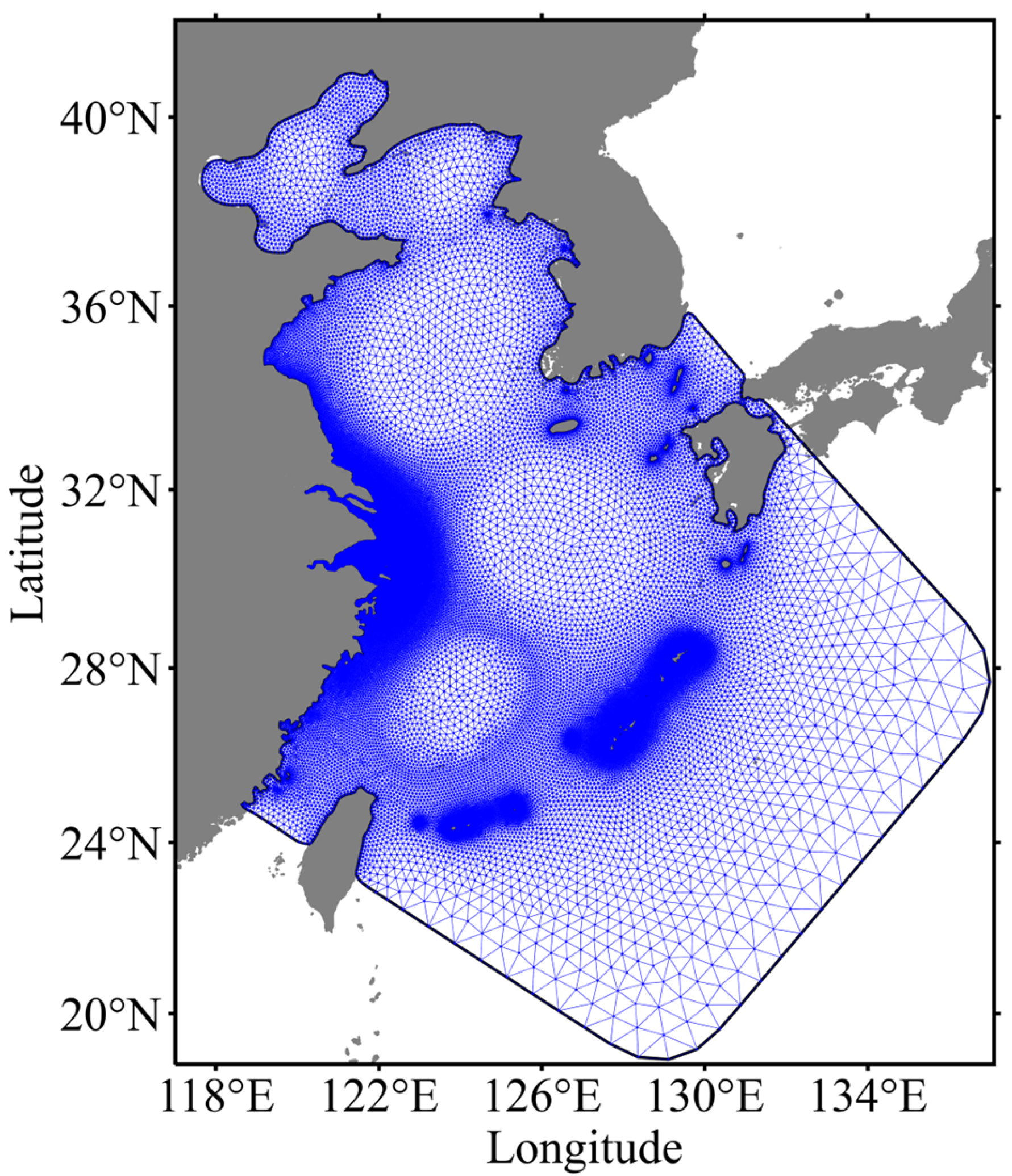

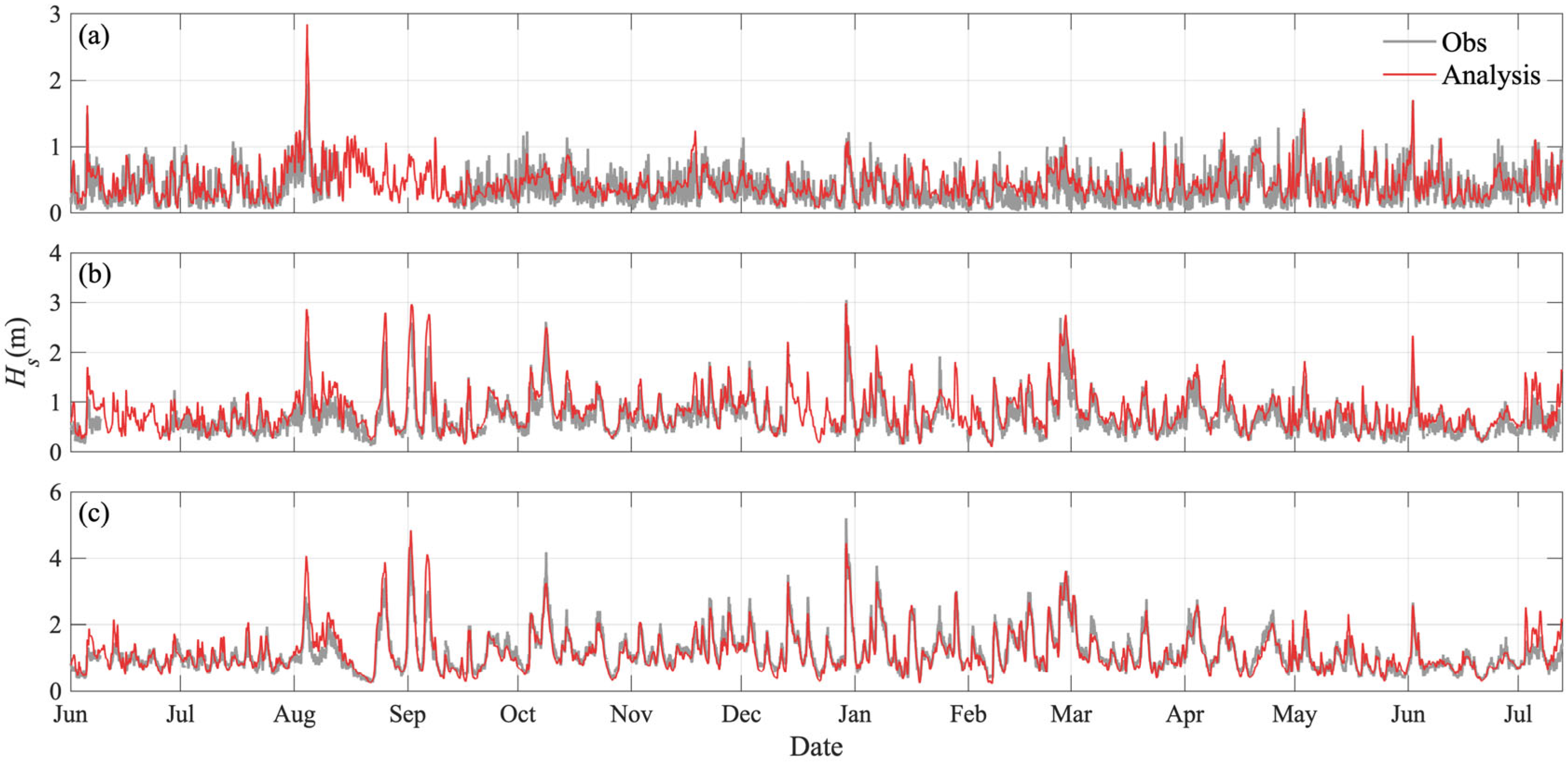
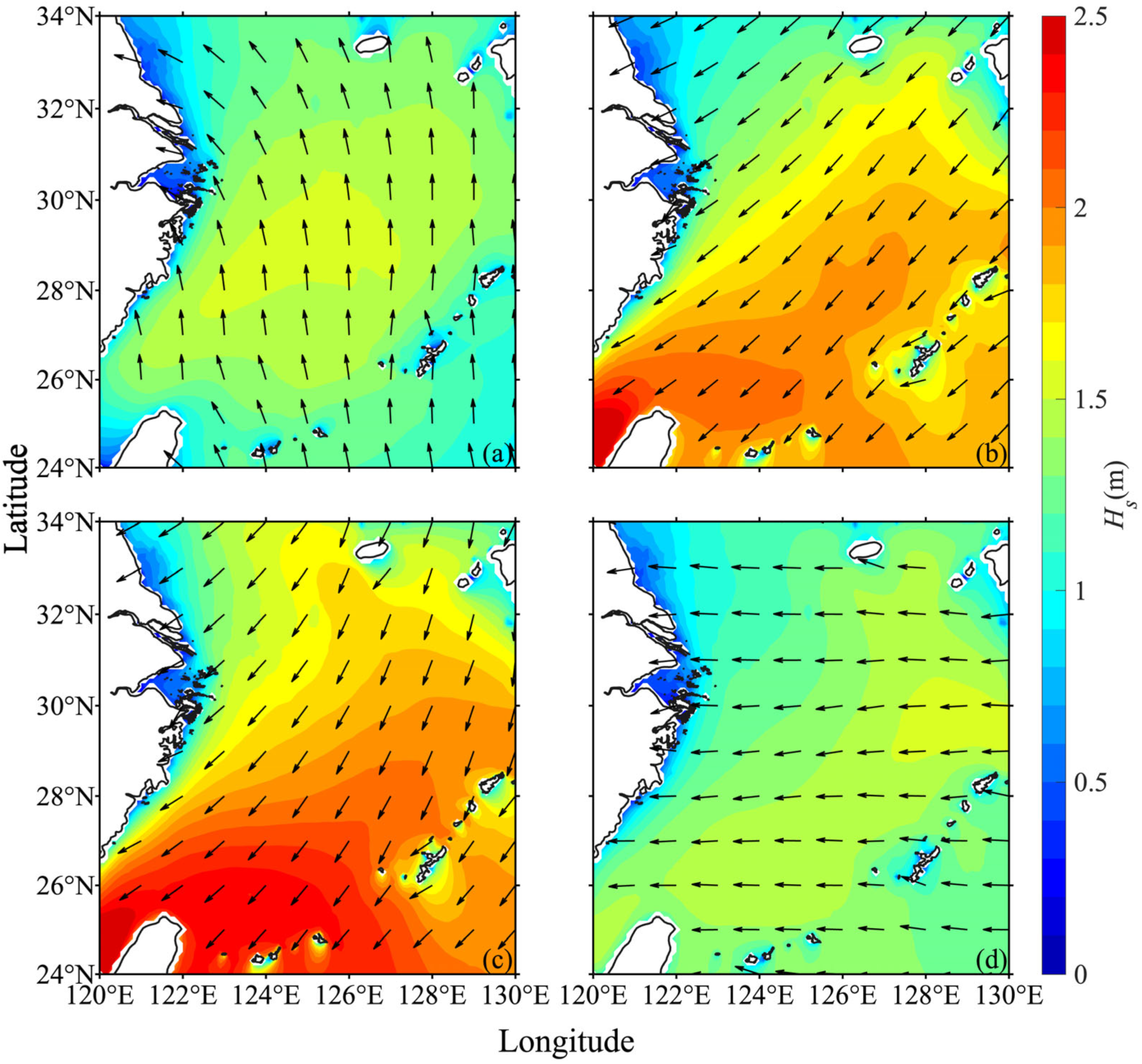

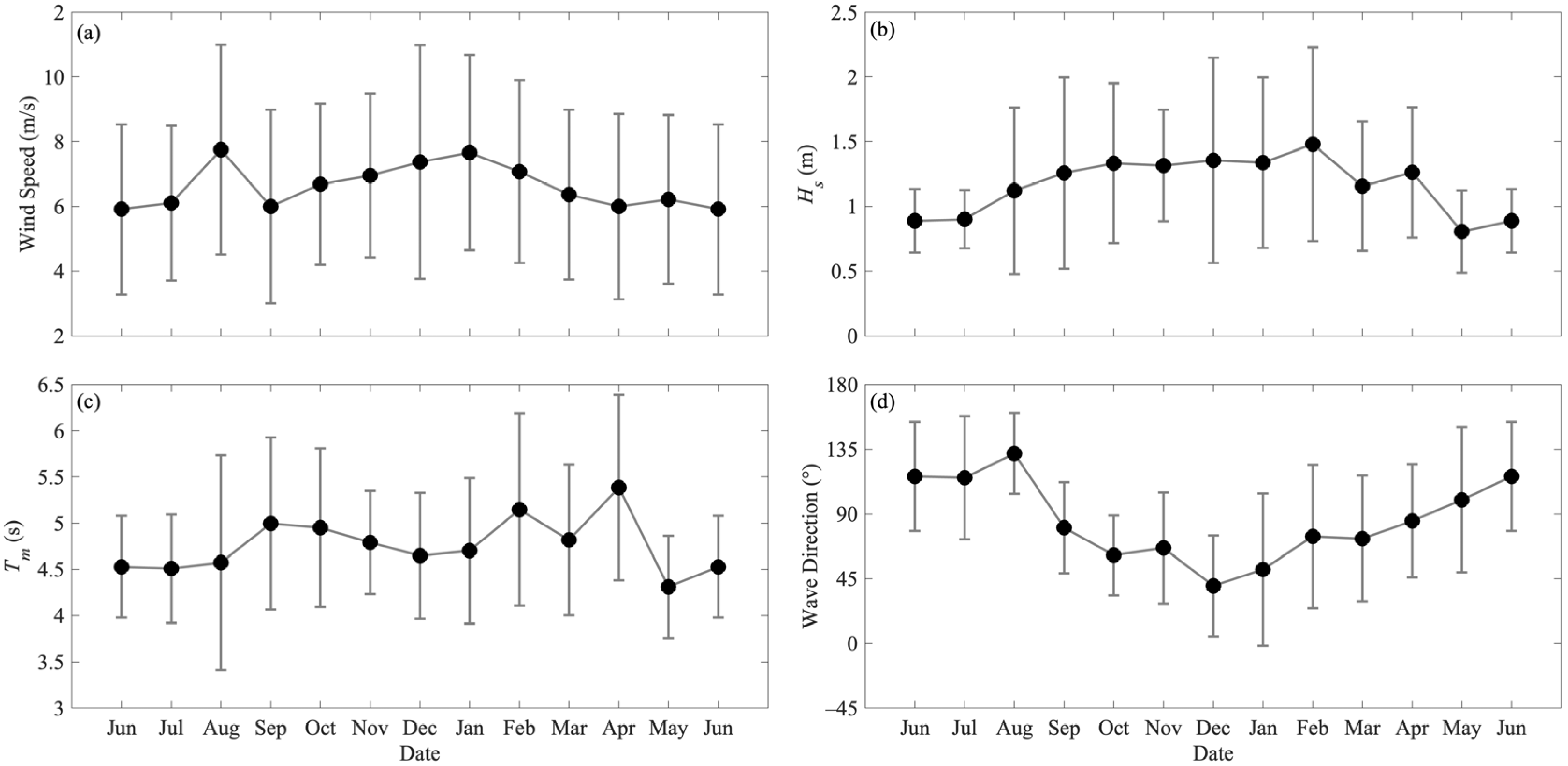
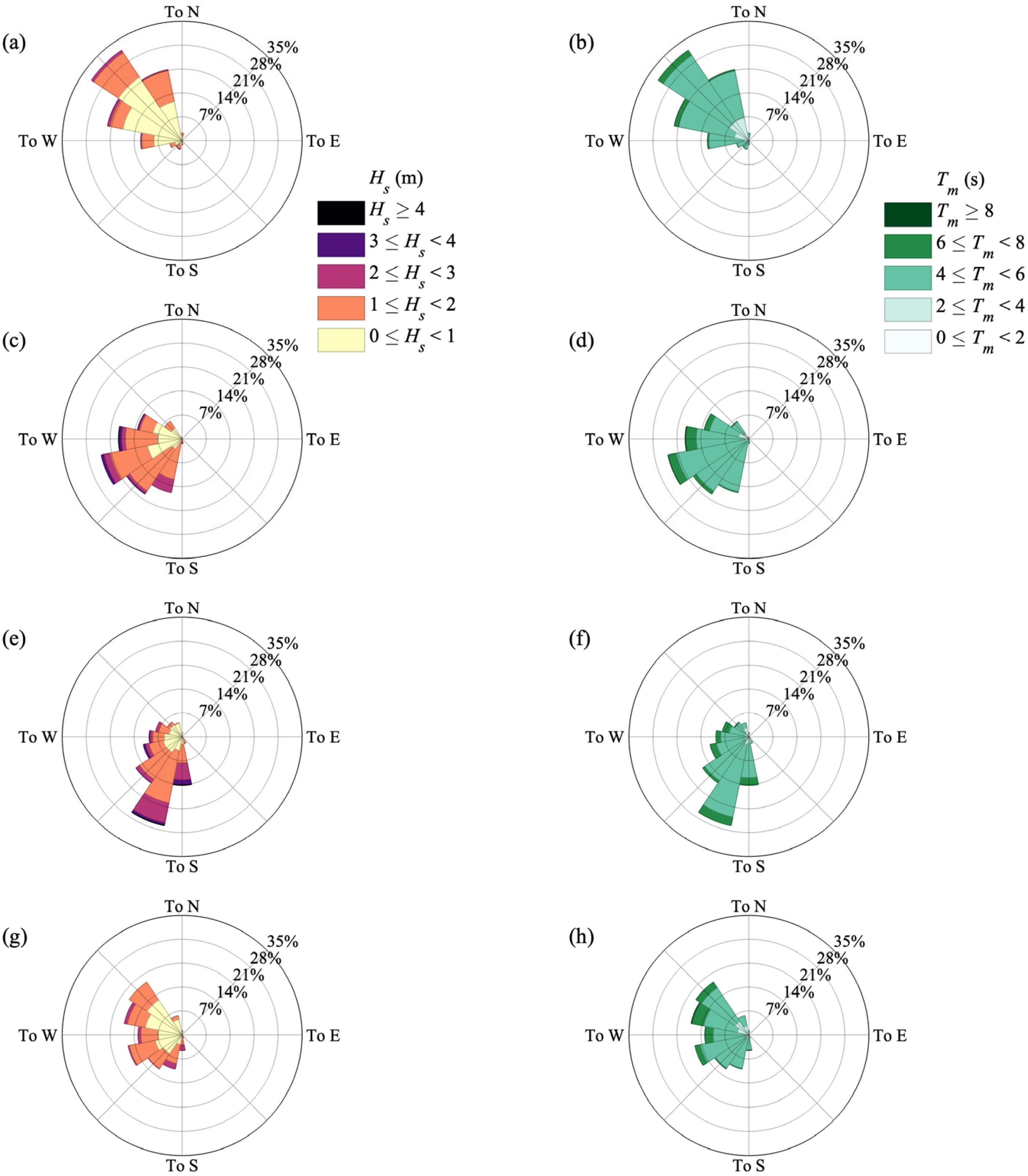
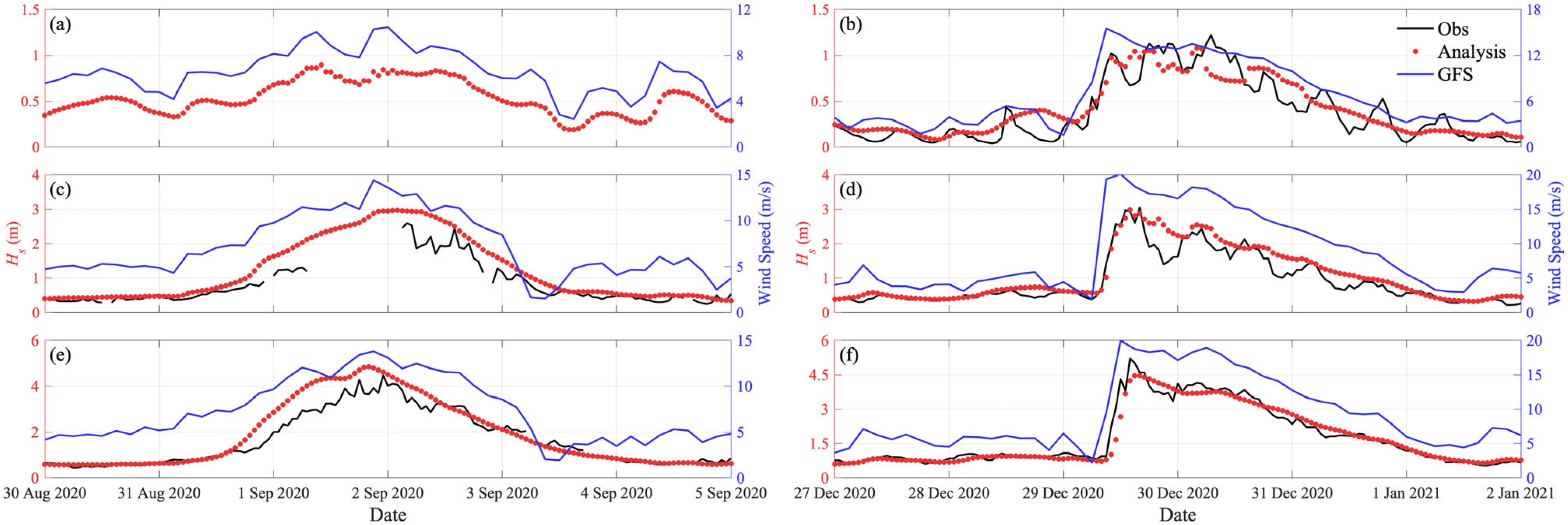

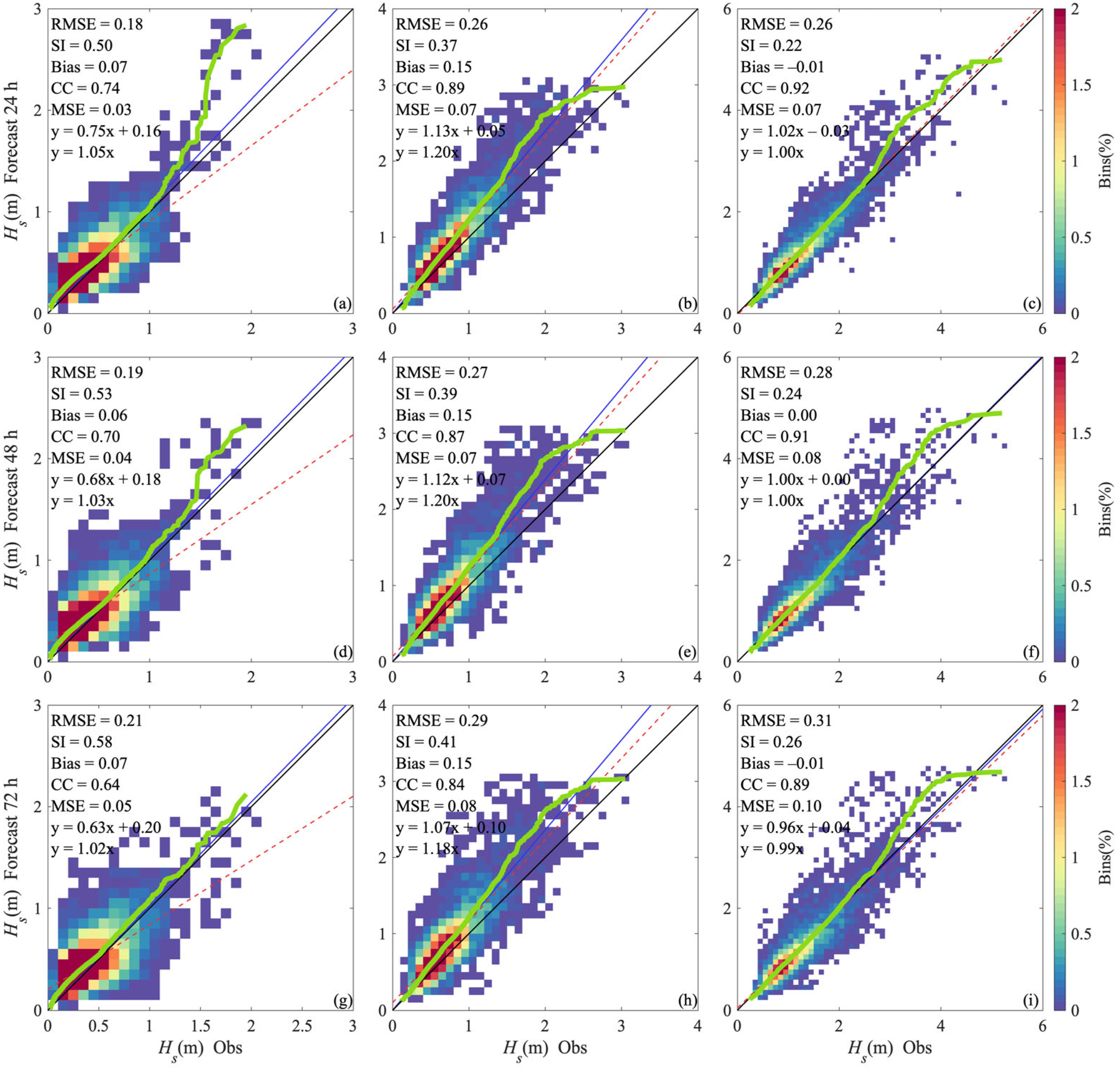



| Buoy | Location | Buoy Type | Data Duration | Depth (m) |
|---|---|---|---|---|
| HU01 | (121.55°E, 30.75°N) | Triaxys | 1 June 2020–13 July 2021 | 9.25 |
| HU02 | (122.81°E, 30.97°N) | Triaxys | 1 June 2020–13 July 2021 | 27.88 |
| HU04 | (122.30°E, 30.97°N) | Triaxys | 1 June 2020–13 July 2021 | 10.38 |
| Station | RMSE (m) | SI | Bias (m) | CC | MSE (m2) | Theil Decomposition | ||
|---|---|---|---|---|---|---|---|---|
| Bias | Variance | Noise | ||||||
| HU01 | 0.18 | 0.50 | 0.07 | 0.75 | 0.03 | 13.38% | 0.02% | 86.6% |
| HU04 | 0.26 | 0.39 | 0.16 | 0.89 | 0.07 | 38.04% | 13.01% | 48.94% |
| HU02 | 0.26 | 0.23 | 0.02 | 0.91 | 0.07 | 0.52% | 3.9% | 95.59% |
| Wind | RMSE (m/s) | SI | Bias (m/s) | CC | MSE (m2/s2) | Theil Decomposition | ||
|---|---|---|---|---|---|---|---|---|
| Bias | Variance | Noise | ||||||
| 24 h forecast | 2.00 | 0.41 | 1.00 | 0.74 | 4.02 | 25.02% | 1.60% | 73.38% |
| 48 h forecast | 2.10 | 0.43 | 0.96 | 0.69 | 4.43 | 20.86% | 1.63% | 77.51% |
| 72 h forecast | 2.27 | 0.47 | 0.97 | 0.63 | 5.16 | 18.42% | 1.28% | 80.30% |
| Station | Forecast Horizon | Bias | Variance | Noise |
|---|---|---|---|---|
| HU01 | 24 h | 13.41% | 0.00% | 86.59% |
| 48 h | 11.00% | 0.08% | 88.92% | |
| 72 h | 10.57% | 0.02% | 89.41% | |
| HU04 | 24 h | 33.41% | 14.16% | 52.43% |
| 48 h | 30.50% | 13.59% | 55.91% | |
| 72 h | 25.99% | 11.44% | 62.57% | |
| HU02 | 24 h | 0.06% | 6.15% | 93.78% |
| 48 h | 0.02% | 5.06% | 94.91% | |
| 72 h | 0.05% | 2.54% | 97.41% |
Disclaimer/Publisher’s Note: The statements, opinions and data contained in all publications are solely those of the individual author(s) and contributor(s) and not of MDPI and/or the editor(s). MDPI and/or the editor(s) disclaim responsibility for any injury to people or property resulting from any ideas, methods, instructions or products referred to in the content. |
© 2023 by the authors. Licensee MDPI, Basel, Switzerland. This article is an open access article distributed under the terms and conditions of the Creative Commons Attribution (CC BY) license (https://creativecommons.org/licenses/by/4.0/).
Share and Cite
Jiang, Y.; Rong, Z.; Li, Y.; Li, C.; Meng, X. Toward a High-Resolution Wave Forecasting System for the Changjiang River Estuary. Remote Sens. 2023, 15, 3581. https://doi.org/10.3390/rs15143581
Jiang Y, Rong Z, Li Y, Li C, Meng X. Toward a High-Resolution Wave Forecasting System for the Changjiang River Estuary. Remote Sensing. 2023; 15(14):3581. https://doi.org/10.3390/rs15143581
Chicago/Turabian StyleJiang, Yan, Zengrui Rong, Yiguo Li, Cheng Li, and Xin Meng. 2023. "Toward a High-Resolution Wave Forecasting System for the Changjiang River Estuary" Remote Sensing 15, no. 14: 3581. https://doi.org/10.3390/rs15143581





